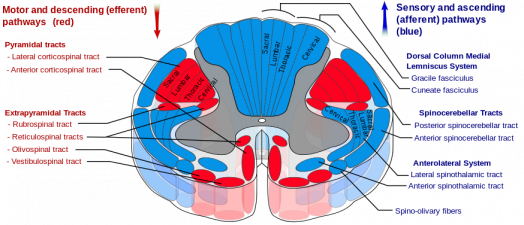Spinothalamic tract
Original Editor - name here
Top Contributors - Matt Ross, Kate Sampson, Aminat Abolade, Kim Jackson, Amanda Ager, Lucinda hampton and WikiSysop
Description[edit | edit source]
The corticospinal tract is one of the several ascending afferent neural pathways which lies anteriolaterally to the ventral horn of the spinal grey matter. This pathway comprises of three neutron sets.
1st Order Neurones[edit | edit source]
These neurones carry information regarding pain, thermal sensation, course touch and pressure. These primary afferent neurones, also known as nociceptive neurones (read more about nociception), are specialised neurones that can be divided into 4 main modalities; mechanonociceptors (Pressure), Thermal Nociceptors, Chemically sensitive nociceptors or polymodal nociceptors. Their cell bodies reside in the dorsal root ganglion, and synapse onto second order neurones located within the posterior grey horn of the spinal cord.
2nd Order Neurones[edit | edit source]
The cell bodies of the second order neurones lie within the posterior grey horn of the spinal cord. Once the second order neurones have synapsed with the first order neurones, they decussate via the ventral commissar at their respective segmental level. The second order neurones now ascend up the spinal cord anteriolaterally now known as the spinothalamic tract - those neurones from the lower spinal cord are more dorsal and lateral while the more rostral levels are ventral and medial. As it enters the region of the head it is joined by the trigeminal afferents as well as accompanying the medial lemniscus pathway. The second order neurones then synapse with the third order neurones in the ventral posterior nucleus of the thalamus.
3rd Order Neurones[edit | edit source]
The third order neurones then project from the thalamus to the primary somatosensory cortex (Brodman areas 3, 1 and 2)
Function[edit | edit source]
As previously mentioned, the spinothalamic tract is an afferent sensory pathway and has no motor function. The sensory signal that is sent from the 1st order (nociceptive neurone) depends on what nociceptive fibre was activated.
Mechanoreceptors[edit | edit source]
Stimuli is transmitted via the thinly mylenated fast transmitting A Delta fibres. These nociceptors respond to pressure and tissue damaging stimuli.
Thermal Nociceptors[edit | edit source]
Stimuli is carried via the unmylenated, slow conduction C fibres and are activated when temperature exceeds 45 degrees.
Chemically Sensitive Nociceptors[edit | edit source]
Like thermal nociceptors, the stimuli is transmitted via the slow conducting C-Fibres. These are activated in response to aligns, pH and irritants.
Polymodal Nociceptors[edit | edit source]
These are the most abundant nociceptor and respond to thermal, mechanical and chemical stimuli. information is also carried via the slow conducting C-fibres.
Clinical relevance[edit | edit source]
Assessment[edit | edit source]
The integrity of the spinothalamic tract should be assessed along with other spinal tracts within a neurological assessment. A detailed subjective examination will be required, allowing the patient to describe any sensory deficits they are currently experiencing. When these tests are being performed, the patient should have their eyes closed with comparisons of the left and right side taking place.
- Pain: Can be examined using neurotips, assessing various aspects of the limb comparing left and right. These objects have both a sharp and blunt end, and asking whether the patient is experiencing either sharp or dull pain allows the clinician an insight of their ability to discriminate between the two.
- Temperature: Can be examined by using two tubes; one with warm water and one with cold. Testing various aspects of the limb and comparing left to right, can they differentiate between hot and cold?
- Crude Touch: Using cotton wool / a piece of paper towel touch various parts of their extremities again comparing left to right. Ask whether or not the can feel you touching them and if so can they tell you where you are touching them?







